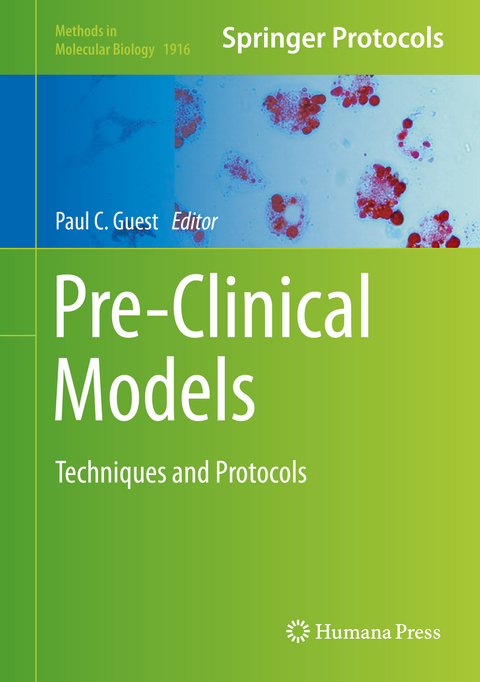
Pre-Clinical Models
Humana Press Inc. (Verlag)
978-1-4939-8993-5 (ISBN)
Authoritative and cutting-edge, Pre-Clinical Models: Techniques and Protocols aims to provide methods that describe the context of specific disease or therapeutic areas.
A Guide to Mass Spectrometry-based Quantitative Proteomics.- Mitochondrial Involvement in Mental Disorders; Energy Metabolism, Genetic and Environmental Factors.- Monosodium Glutamate (MSG)-induced Animal Model of Type 2 Diabetes.- The Elevated Plus Maze Test for Measuring Anxiety-like Behaviour in Rodents.- The Forced Swim Test for Depression-like Behaviour in Rodents.- Object Burying Test for Assessment of Obsessive Compulsive Behaviours in Mice.- The Nest Building Test in Mice for Assessment of General Well-being.- Mouse Free Dyadic Social Interaction Test.- The Open Field Test for Measuring Locomotor Activity and Anxiety-Like Behaviour.- The Y-maze for Assessment of Spatial Working and Reference Memory in Mice.- Maturation of a Human Oligodendrocyte Cell Line.- Monitoring Age-related Changes in the Lactate/pyruvate Ratio using a Colorimetric Assay in a C. elegans Model of Increased Lifespan.- Isolation and Characterisation of Different Mesenchymal Stem Cell Populations from Rat Femur.- Characterization of an Animal Model of Autism and Social Interaction.- Assaying Reproductive Capacity in Female Rodents.- Experimental Model of Hindlimb Suspension-Induced Skeletal Muscle Atrophy in Rodents.- An Analysis of the Intracellular Signal Transduction of Peripheral Blood Leukocytes in Animal Models of Diabetes using Flow Cytometry.- Characterization of the db/db Mouse Model of Type 2 Diabetes.- Characterization of the Goto-Kakizaki (GK) Rat Model of Type 2 Diabetes.- Characterization of Human Transplantable Insulinoma Cells.- Preparation of Islets from Rat Pancreas and Assessment of Islet Function.- Cryopreservation of Red Blood Cells.- Molecular Characterization of Human Leukemia 60 (HL-60) Cells as a Model of Acute Myelogenous Leukemia Post Cryo-preservation.- Reprogramming of Human Melanocytes and Melanoma cells with Yamanaka Factors.- The Use of 3T3-L1 Murine Preadipocytes as a Model of Adipogenesis.- Generation of Human Pyruvate Carboxylase Knockout Cell Lines UsingRetrovirus Expressing Short Hairpin RNA and CRISPR-Cas9 as Models to Study its Metabolic Role in Cancer Research.- The use of Primary Hepatocytes in Assessment of Drug Safety and Toxicity.- OVA-induced Allergic Airway Inflammation Mouse Model.- Description of Ovariectomy Protocol in Mice.- A Rat Eye Lens Model of Cataract Formation.- A Complete Proteomic Workflow to Study Brain-Related Disorders via Postmortem Tissue.- Method Protocols for Metabolic and Functional Analysis of the BRIN-BD11 β-Cell Line– a Preclinical Model for Type 2 Diabetes.
| Erscheinungsdatum | 01.02.2019 |
|---|---|
| Reihe/Serie | Methods in Molecular Biology ; 1916 |
| Zusatzinfo | 73 Illustrations, color; 17 Illustrations, black and white; XIII, 343 p. 90 illus., 73 illus. in color. |
| Verlagsort | Totowa, NJ |
| Sprache | englisch |
| Maße | 178 x 254 mm |
| Themenwelt | Medizin / Pharmazie ► Medizinische Fachgebiete ► Pharmakologie / Pharmakotherapie |
| Medizin / Pharmazie ► Pharmazie | |
| Naturwissenschaften ► Biologie ► Zoologie | |
| Schlagworte | Animal-based models • Biomarkers • Disease Modeling • drug discovery • pharmaceutical research |
| ISBN-10 | 1-4939-8993-6 / 1493989936 |
| ISBN-13 | 978-1-4939-8993-5 / 9781493989935 |
| Zustand | Neuware |
| Informationen gemäß Produktsicherheitsverordnung (GPSR) | |
| Haben Sie eine Frage zum Produkt? |
aus dem Bereich


